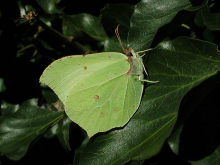
| Butterfly Conservation |
 |
| Hertfordshire & Middlesex Branch |
 |
|
|||
| Saving butterflies, moths and our environment | ||||


BrimstoneGonepteryx rhamniWidespread Distribution and Status The Brimstone is probably the most stable of all our butterflies in our branch area as well as in Britain as a whole. Being a strong flier, it can travel long distances to colonise new sites if existing breeding grounds are no longer suitable. Changes in the butterfly's distribution and abundance are usually quite small year by year although populations fluctuate more widely at each locality. It is possible that increased distribution in Middlesex since the 1980s owes to more planting of buckthorn in urban gardens Habitat Requirements Almost anywhere in the wider countryside although in the early spring they are more likely to occur in wooded areas where most adult specimens hibernate Larval Foodplants Alder Buckthorn Frangula alnus, Purging Buckthorn Rhamnus catharticus. Other foodplants which are very rarely taken for egg-laying are Curled Dock Rumex crispus and possibly Dogwood Cornus sanguinea Adult Food Sources Buddleia Buddleja davidii, Wild Teasel Dipsacus fullonum , Runner bean Phaseolus coccineus Behaviour/Observation notes The Brimstone is more active in the spring when both sexes seek out a mate. Males spend time patrolling hedgerows and woodland edges to search for females which generally emerge from hibernation later. Because of the more frenetic activity of the butterflies at this time they are more difficult to approach. However, after mating has occurred, males spend more time feeding and females egg-laying, facilitating an easier approach for close-up photographs Life History This species can be seen in every month of the year as it overwinters as an adult. It is most active in the spring when peak numbers usually occur in April. The hibernating individuals may even be flying in early July when the emergence of the new generation begins. The eggs are usually laid singly under a buckthorn leaf in early May with caterpillars hatching out by the end of the month. When larvae are fully grown they usually pupate away from the foodplant. Just before emergence of the adult butterfly, a spot on the forewing can be seen through the pupal case Further information
UK distribution map |
Copyright Butterfly Conservation © 2019 Hertfordshire & Middlesex Branch
Privacy and Copyright Statement and Cookie Policy Statement
Butterfly Conservation
Company limited by guarantee, registered in England (2206468)
Registered Office: Manor Yard, East Lulworth, Wareham, Dorset, BH20 5QP. Tel: 01929 400 209
Charity registered in England & Wales (254937) and in Scotland (SCO39268). VAT No. GB 991 2771 89